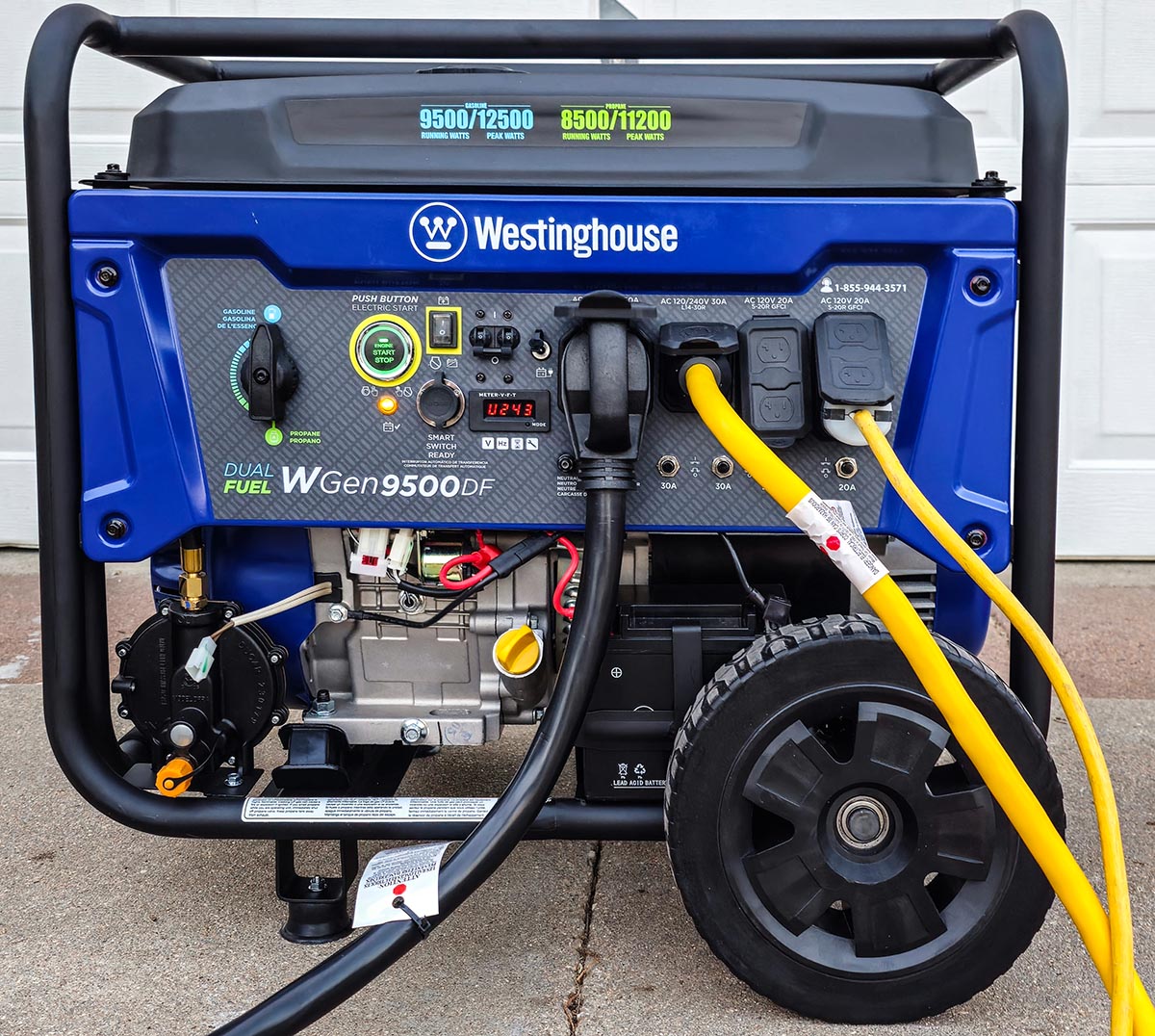

We may earn revenue from the products available on this page and participate in affiliate programs. Learn More ›
It’s unwise to leave power needs up to chance—especially during an emergency situation or while enjoying off-grid adventures—and that’s where a portable generator can come in. I tested the Westinghouse WGen9500DF generator, a dual-fuel powerhouse that features an impressive capacity of up to 12,500 peak watts and a reliable 9,500 running watts. This generator performed better than I thought it would during a battery of tests I designed to mimic what an end-user would want.
As part of a comprehensive team test to determine the best portable generators, I tried out the WGen9500DF at my own workshop and rural residence. This generator runs on either gasoline or propane—and switching from one to the other is a breeze. In my tests, it easily powered several appliances and tools, including lights, power tools, a 30-amp dryer, and a 50-amp oven/range combo—although not all at the same time. Ahead, find out what I liked about the WGen9500DF, what I loved, and what I wished Westinghouse would do differently to improve this model.
Westinghouse WGen9500DF Generator: At a Glance
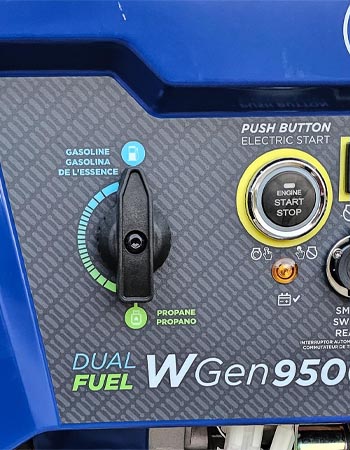
Rating: 9.25/10
SPECS
- Gasoline peak watts: 12,500
- Propane peak watts: 11,200
- Power outlets: (2) 20A, (1) 30A, (1) 50A
- Start options: Push-button, remote-start key fob, recoil
- Additional options: Transfer switch ready (switch sold separately)
- Dimensions: 26.5 inches high by 27.2 inches long by 26.1 inches deep
- Weight: 211 pounds
PROS
- Delivers an impressive peak output of 12,500 watts and a running output of 9,500 watts
- Operates on both gasoline and propane, providing users with flexibility in choosing their preferred fuel source
- Features electric, remote, and recoil start options, making it easy to start in various situations
- VFT Data Center provides real-time information on voltage, frequency, and runtime hours
- In-the-box accessories include an oil bottle, funnel, spark plug wrench, remote, and a battery float charger
- Built with a durable cast-iron sleeve and a dependable 457cc 4-stroke OHV engine for long-lasting performance
- Offers a variety of outlet options, including household duplex outlets, twist-lock outlets, and more for powering different devices
CONS
- VFT mode button for the digital display is tiny and challenging to use
- The generator’s noise level, measuring 89 decibels at 6 feet away, is relatively loud, potentially causing disturbance in residential areas
- At 211 pounds, the generator is quite heavy, making it challenging to move or transport without assistance; a designated trailer may be necessary for portability
Get the Westinghouse WGen9500DF at:
What is the Westinghouse WGen9500DF generator?
The WGen9500DF is a portable dual fuel generator, meaning it’s not stationary and it’s capable of running on gasoline or propane (LPG). I’ve only had gasoline-powered portable generators in the past, so this was something new and exciting to try out. Westinghouse has been a prominent name in the electrical and electronics industry for over a century, dating back to the pioneering work of George Westinghouse. The Westinghouse brand has a legacy of introducing innovative technologies, and its current line of generators is no exception.
Powered by a robust 457cc 4-stroke OHV Westinghouse engine with a durable cast-iron sleeve, the WGen9500DF’s user-friendly features include a built-in fuel gauge that’s easy to see, automatic low-oil shutdown, and GFCI outlets for added safety. The convenience of a remote- start key fob (my favorite feature) makes starting effortless, even from a distance.
This generator is transfer switch ready. This means it can be directly wired into a home’s electrical panel and when the power goes out, the generator will self-start and send electricity through the home’s installed circuits. Unfortunately, that’s the one feature I didn’t test because the transfer switch sells separately. Furthermore, I’m not a fan of transfer switch integration for this size generator—transfer switches are typically designed for standby generators that provide enough power to supply an entire home’s electrical needs. Additionally, there can be safety issues connecting a portable generator to a home’s electrical system, so should consumers choose to install a transfer switch, I recommend having a pro electrician hook it up.
With this generator’s portability features (which include heavy-duty, never-flat wheels and a handle), an individual’s home, travel trailer, or jobsite can be powered up quickly. The WGen9500DF is a top choice for anyone looking for a backup power solution, an emergency generator, or even remote workshop power.
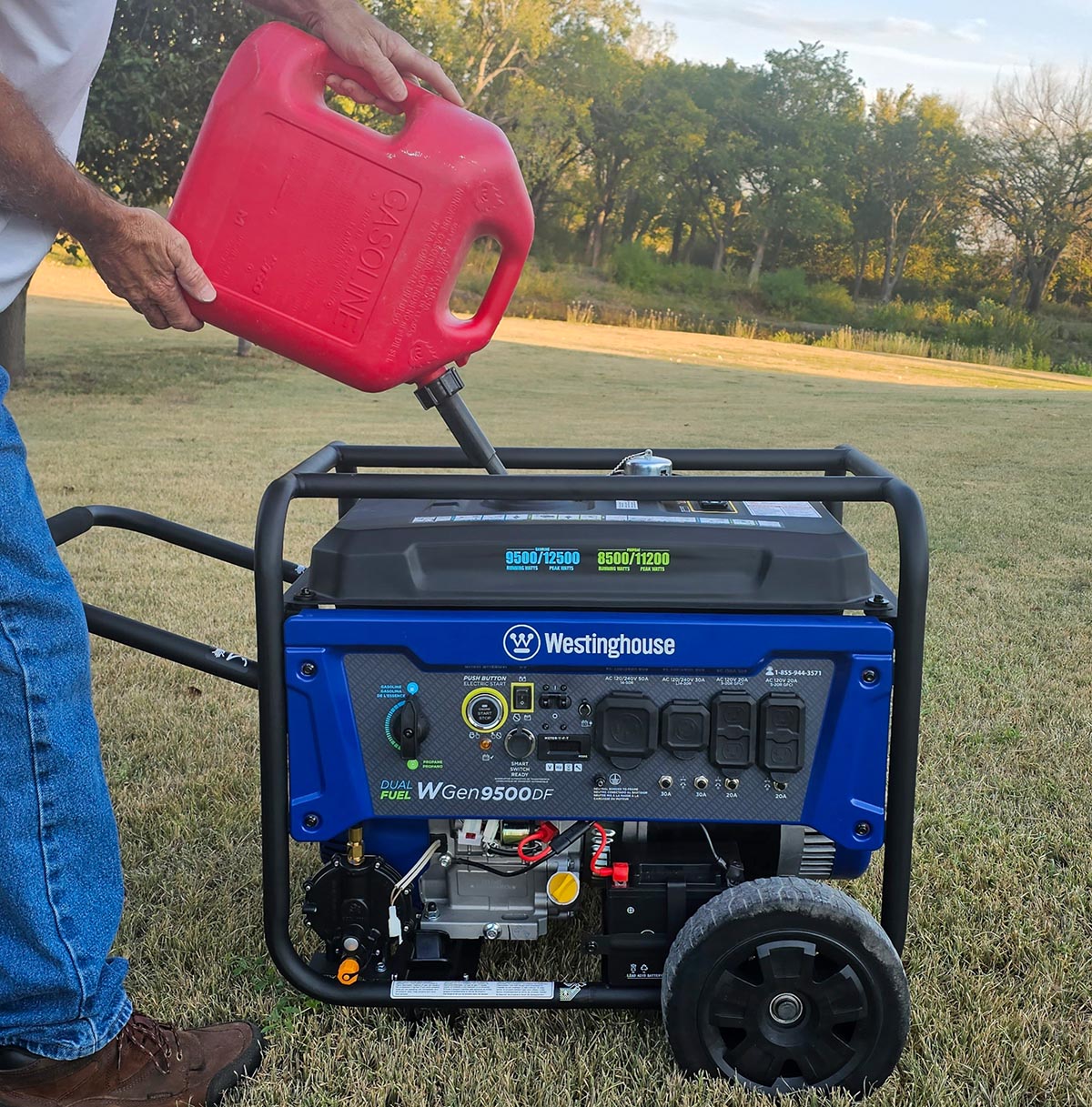
How long will it run on a full tank of gasoline? What about propane?
The generator is rated to run up to 12 hours on a full 6.6-gallon tank of gas when operating at 25 percent load. However, I found that the time varied depending on several factors, such as the gasoline quality and the power I was pulling.
I ran it for the first 5 hours (recommended break-in period) on gasoline only, and during that period, I ran a couple of corded power tools, a small space heater, and some lights. After the break-in period, I refilled the tank to the top, connected a large shop compressor, and used it to power several pneumatic tools. I estimate I was pulling about a 40 percent load, which fluctuated as the compressor cycled with tool use. The tool use wasn’t constant, but at the end of a 6-hour day of frequent tool use in the workshop (with the generator running the whole time), I checked the gas tank, and it was still about a third full.
Westinghouse rates the WGen9500DF as running up to 7 hours at a 50 percent load on propane. I had a propane tank with what I estimated was about 18 to 20 gallons, and on the day I tested the unit with propane, the generator ran for just over 6 hours. During that test, I was pulling a load similar to what was used for the gasoline tests—my shop compressor and frequently used pneumatic tools. So, yes, it ran slightly less (time-wise) on propane. I’d advise users to compare the going prices for gasoline and propane in their local region, because actual cost efficiency may vary depending on the fuel price.
For those who plan on running the generator mainly on propane, it may be most economical to connect a designated line from a large bulk propane tank. That’s because propane is typically cheaper when delivered in bulk.
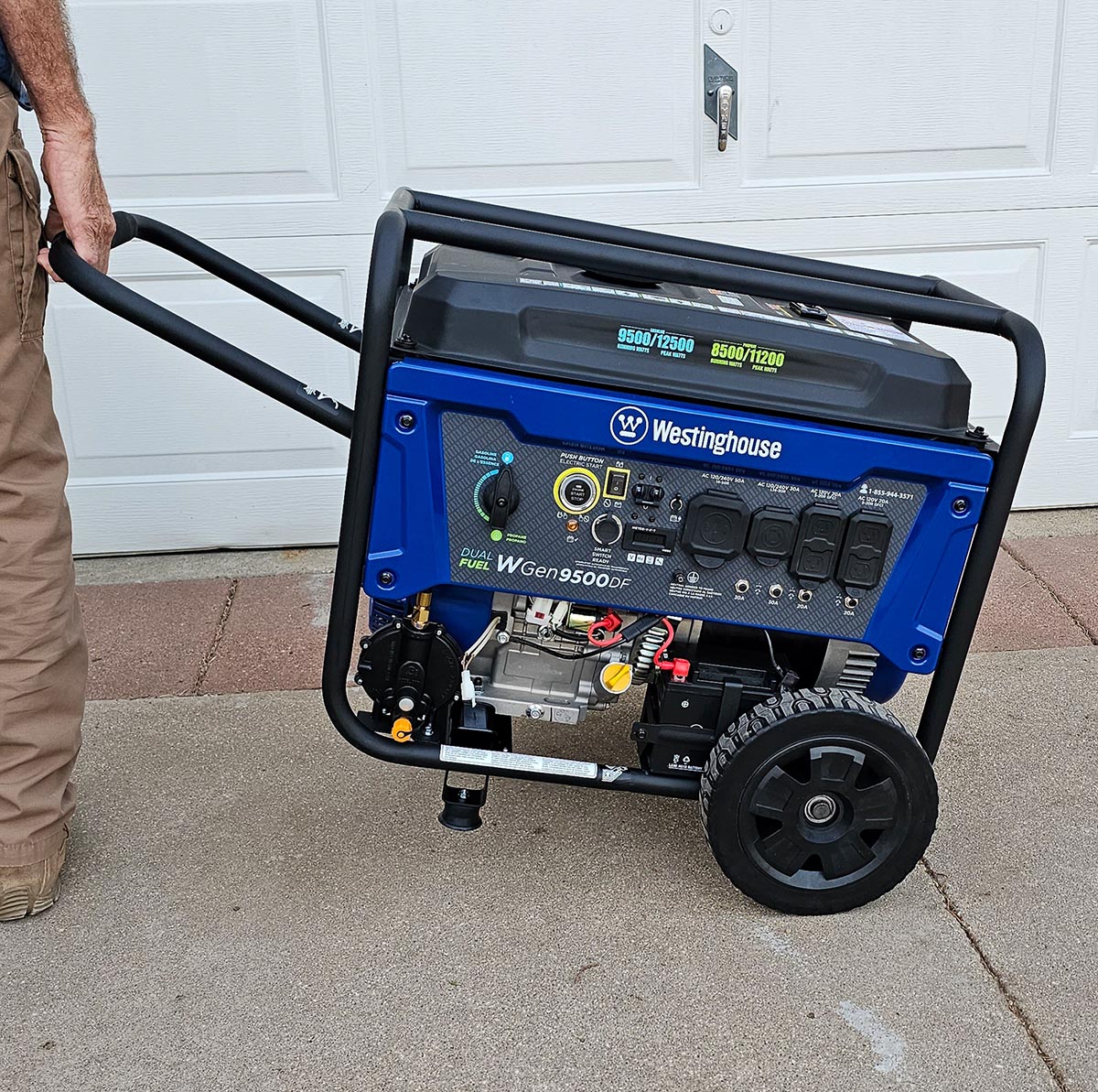
How user-friendly is the WGen9500DF?
First off, this is a heavy generator, so users will want to plan to have a way to transport the box when it’s delivered. The generator itself weighs 211 pounds, and with the box and pallet it comes on, it weighs 226 pounds. A heavy-duty hand truck or rolling pallet will be necessary to get the unit where the user wants to uncrate and assemble it.
Assembly is easy, but again, it’s heavy, so users will need a way to lift it slightly while attaching the wheels. Once the two wheels are installed, portability improves and it’s much easier to tip it up and pull it where needed. Loading it on a trailer bed or in the back of a truck, however, will take two or three strong helpers.
Starting and operating the WGen9500DF is straightforward and intuitive. There’s no need for a propane conversion kit—it’s all built into the machine. It has a clearly marked fuel selector: All the user needs to do is turn it straight up to run the generator on gasoline and downward to run it on propane.
Filling the gas tank proved a snap via a large cap on the top of the generator. Equally easy to use, the propane tank connects with a standard compression fitting to a valve at the bottom of the machine. Once the fuel source was connected (or the tank filled), I just turned the battery switch to the “on” position and pushed the “start” button on the machine (or used the remote), and the generator roared to life. It also comes with a handy recoil cord if the battery that powers the electric start runs down. I gave the cord a medium-power pull, and the generator started right up.
The manufacturer claims the remote control will work from 90 feet away. I measured, however, and the farthest away I could stand and still start the machine by remote was 35 feet. I wondered if the battery in the remote was low on charge, so I swapped in a new battery. Sure enough, I was then able to start the generator from fully 90 feet away. Impressive!
Additionally, each power outlet on the generator is clearly marked and has a rubber cap that fits over it snugly to protect from dirt, dust, and moisture when not in use.
The WGen9500DF also features a VFT Data Center that provides real-time information on voltage output, frequency, and lifetime hours. I liked the idea of the data center, but the downside is its tiny mode button, barely bigger than the head of a pin, that I had to press to toggle through the display modes. I finally ended up leaving it set on “hours” because I could see at a glance the total hours the machine had been used. If the mode button were larger, it’d be more usable. Overall, though, I found the WGen9500DF to be a very user-friendly generator.
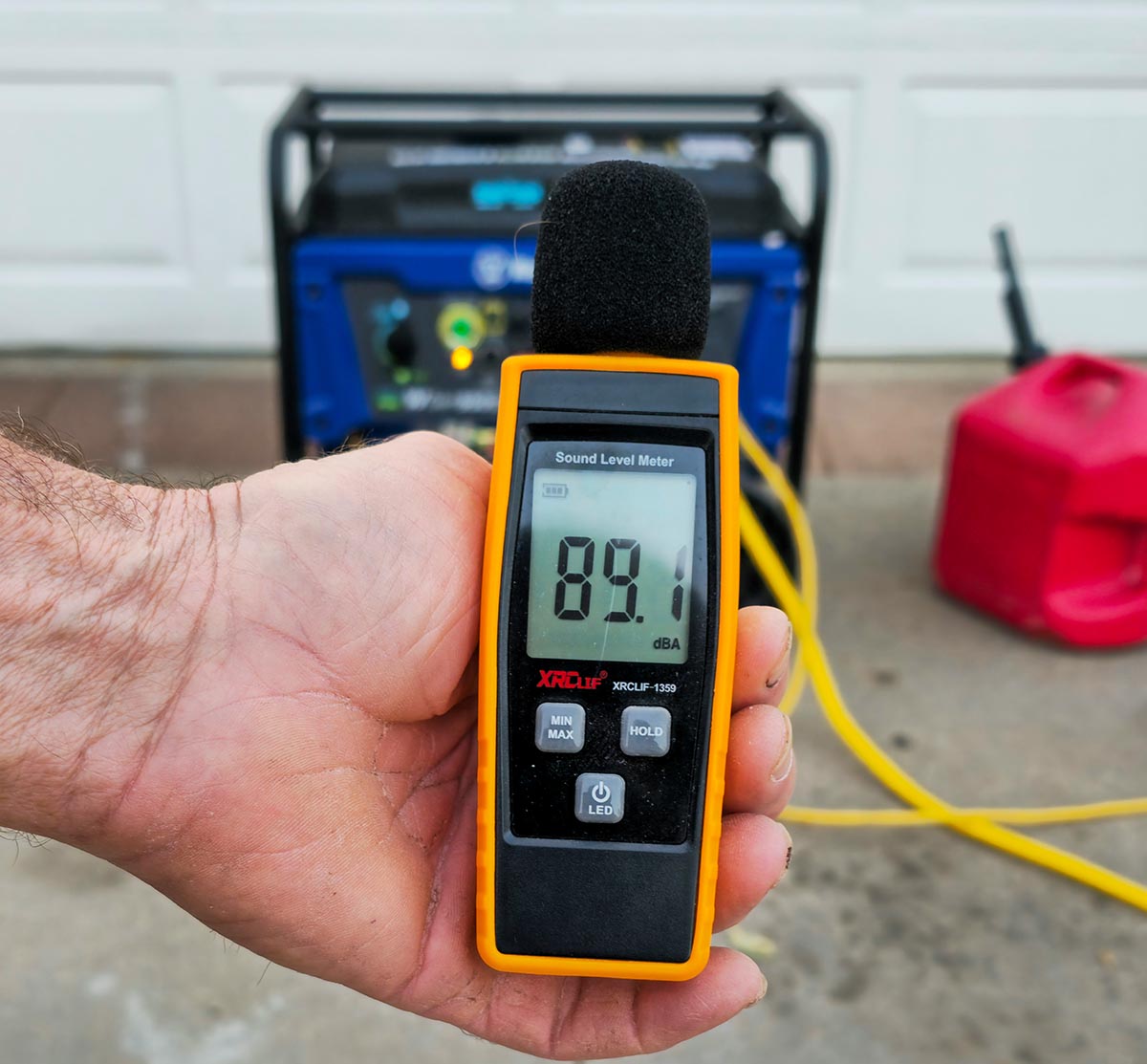
How loud is the WGen9500DF when it’s running?
This generator is pretty loud—comparatively speaking. It’s about as loud as any fuel-powered generator I’ve been around. I tested the generator with my decibel tester from about 6 feet away, and it toggled between 89 and 90 decibels. According to Purdue University, that’s about equal in sound to a motorcycle passing by 25 feet away.
Changing the fuel from gasoline to propane didn’t affect the sound level—it stayed the same no matter what. After a few minutes of testing, I went in search of some hearing protectors, which made it much more comfortable to be around the machine. I found I was also able to get some relief from the noise if I put the generator outside on the concrete and then ran an extension cord inside my workshop while using it to power a variety of tools, including a table saw, an air compressor, a lathe, and a drill press.
The manufacturer lists the decibels at just 74, but I believe the testers at Westinghouse must have been standing at least 75 feet away to get that reading. Up close, where most users will be—at least initially—it’s quite a bit louder.
How much can I power at once with the WGen9500DF?
I was able to power several standard power tools at the same time without any drop in power, and (at separate times) an oven/range combo and a clothes dryer. Users can use an online chart that tells the average estimated watts for most household appliances. All a user needs to do is add up the appliances that need to run and ensure the total is under 9,500 watts if using gasoline and under 8,500 watts if using propane.
The WGen9500DF features peak watts (the highest surge in power) of 12,500 when it’s operating on gasoline and 9,500 when running on propane. But peak watts are only for the surges that typically happen when a tool or appliance starts up. After that, the power draw settles back to a base running speed. The trick is to run fewer watts than the maximum running speed for the relative fuel. This means users may be able to power a fridge, an electric skillet, a microwave, and a few other appliances simultaneously, depending on the total combined watts they pull.
Should a user overload one of the circuits (one of the outlets) beyond its capability, the outlet breaker will trip. I only tripped one breaker, and by reducing the load (unplugging a heater) and then pressing the breaker reset button beneath the outlet, I was able to continue testing. Overall generator performance will ultimately depend on several factors, including fuel type (propane or gasoline) and the type and amperage of the appliances and tools an individual wishes to run.
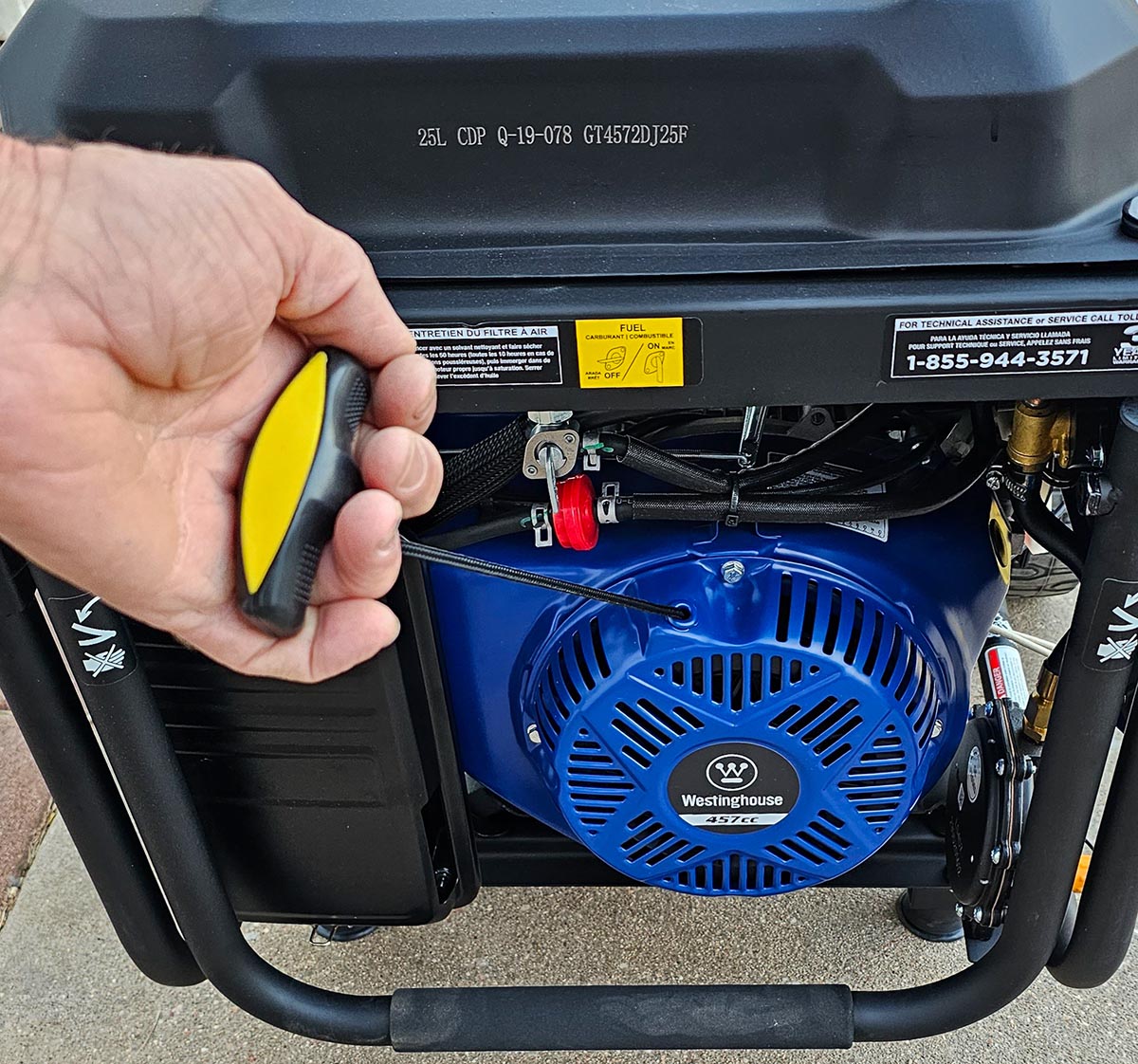
Is the Westinghouse WGen9500DF worth the money?
At first glance, the Westinghouse WGen9500DF generator may appear to be just another option in the crowded world of portable power solutions. However, a closer examination reveals that it holds its own and offers substantial value for its price.
With a price tag ranging from about $1,000 to $1,300, depending on the individual retailer, the Westinghouse WGen9500DF falls within a competitive bracket, aligning closely with models of similar build quality and power output. What I think sets it apart and makes it worth every penny is its balanced blend of power, versatility, and user-friendly features. The remote-start key fob is a real game changer when it’s bitterly cold outside and the user prefers to start the generator while still inside a warm house.
The WGen9500DF boasts a robust power capacity, delivering up to 12,500 peak watts and a dependable 9,500 running watts. This power level means it can handle various tasks, from running essential appliances during power outages to powering recreational equipment during camping trips. Its dual-fuel capability, running on gasoline and propane, allows users to choose their preferred fuel source, making it adaptable to different situations.
Should you buy the WGen9500DF?
Those looking for a powerful yet portable dual-fuel generator may find the WGen9500DF generator to be just the ticket. However, it may not be ideal for those seeking whole-house coverage, lighter-weight mobile convenience, or a noise-sensitive solution. Understanding your specific needs and priorities will help you determine whether the WGen9500DF is right for you.
If you live in an area prone to power outages and need a reliable backup power source to keep essential appliances and systems running, the WGen9500DF is an excellent choice. Also, if you have a remote workshop or outbuilding without access to electricity, this generator can provide the necessary power to run tools, lights, and equipment, making it a top choice for DIY enthusiasts and professionals.
Individuals or families looking for an off-grid generator to power essential appliances, lighting, or electronics will likely find the WGen9500DF a dependable electricity source. But users will want to remember its power limitations—it won’t run everything in a large home.
Those with access to a bulk propane supply may find the dual-fuel capability advantageous, as propane often has a longer shelf life than gasoline. For those who plan to connect the generator to a dedicated propane line, it can provide a reliable and continuous power source.
However, a standby generator might be a better fit for those looking for a versatile power source that can power an entire home during an outage. Standby generators are sized and installed to provide full-house coverage based on the home’s square footage and electrical needs.
Additionally, for those who need a highly portable generator for frequent excursions or tailgating, the WGen9500DF’s hefty 211 pounds may be impractical for on-the-go use. For those situations, shoppers may want to consider smaller, more lightweight portable generators. And if noise is a significant concern, especially in residential areas, the generator’s reported 74 decibels (89 to 90 in testing) may be too loud for comfort. Inverter generators or quieter models may be a better choice in such cases.
Where to Buy the Westinghouse WGen9500DF Dual-Fuel Generator
Get the Westinghouse WGen9500DF at:
Meet the Tester
Glenda Taylor is a product tester and writer specializing in the construction, remodeling, and real estate industries. She and her husband own a general contracting company, and Taylor is experienced in both residential and commercial building applications. She tests a wide range of power tools as well as other home improvement, household, and lawn-and-garden products.
